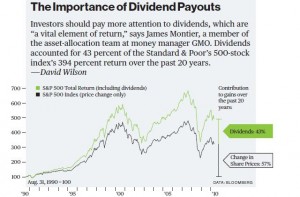Dividends accounted for 43% of the total return in the stock market over the past 20 years. With the S&P500 as a proxy, almost half of the total return of 394% was due to these dividend payouts. I’d heard anecdotally over the years that dividends accounted for various portions of total return, but this is the most recent and comprehensive study and graphic I’ve seen courtesy of this week’s f BusinessWeek edition:
(click to enlarge)
While investors are often focused on the hottest trend like gold investments or sexy tech names like Apple and Research in Motion, what’s occurring slowly but surely in the background is older, stalwart names are returning cash back to shareholders in the form of dividend payouts and providing capital appreciation and acceleration of dividends to boot. This result in such a high share of stock returns in the form of dividends was surprising to me!
Which Companies Pay Great Dividends?
Now, of late, Financials are no longer delivering the juicy yields they used to given their near obliteration and the ensuing TARP restrictions on dividend payouts. I do anticipate that some of the larger names will start to resume higher payouts again in the next couple years, but we may very well be looking at another leg down in the economy as a whole, and FINREG did nothing to help their bottom lines by restricting the use of leverage, fees they impose upon customers and dozens of new regulations so Financials may not be where you want to be. However, there are probably a dozen other sectors that routinely pay out strong dividend yields, while increasing payouts somewhat routinely as well. Some ideas worth checking out:
Real Estate Investment Trusts -There are various segments of real estate investment trusts ranging from shopping malls to medical facilities, but as a whole, they are known for throwing off high yields given the business structure they adhere to which necessitates high payouts as a portion of total income. Here’s a huge list of REITs to check out. They often yield north of 5%.
Master Limited Partnerships -MLPs are often referred to as the best kept secret of the individual investor since many institutional investors aren’t allowed to invest in these instruments due to their tax structure. Essentially, given the special tax treatment they receive, which allows them to throw off outstanding dividends, pensions and other tax-advantaged institutional accounts cannot hold them. That leaves them in somewhat of a niche category. Here’s more on MLP Investments and other factors like taxes and IRAs, but for simplicity, a newly launched MLP ETF was just introduced with much fanfare.
Preferred Stocks – Somewhat of a hybrid between a stock and a bond, there are many preferred stocks yielding north of 7%. As long as the underlying companies remain solvent, you’ve in good shape. There is however, an equity component, so shares can be volatile. Here’s some more background on Preferred Stocks.
Utility Stocks – These are traditionally your grandma’s investment given the lower volatility and steady payouts that retirees rely on monthly or quarterly, but Utilities have been getting more attention of late. Given the near zero interest rates on traditional savings and bond vehicles, Utilities are starting to catch on. Here’s more on Utility Stock ETFs.
Good Old Dividend Growing Stocks -While there are only 4 AAA Companies left in the S&P500, stocks like P&G, Coke, Pharmas, Tobacco and others have routinely paid out and grew their dividends over the years. Many income investors like to focus on dividend growth over current dividend yield since they figure the share price will follow to maintain a steady yield as dividends increase. Sometimes when a stock is yielding 8% or more, the market is pricing in a dividend cut, which is what we saw in 2008 and 2009 in epic fashion. However, of late, companies are sitting on hoards of cash and are widely expected to continue with dividend increases since they’re earning nothing on cash and they’re cutting headcount along the way.
Dividend Tax Considerations
Now, a primary concern for dividend investors is what’s going to happen if the Bush tax cuts are rolled back and dividend tax rates increase from the current 15% rate. For the most part, this risk should already be factored in to share prices, as this has been common knowledge for probably a year now. And, actually, if there’s a surprise reversal and extension of lower dividend taxation rates during the horse trading activities that are sure to ensue in Congress, dividend payers may actually get a boost.


{ 4 comments… read them below or add one }
Good post, many investors do not realize the role dividends play in long-term stock returns. As with all things investors need to balance dividends with the overall prospects of a given stock, fund, or other income producing vehicle (REITs, MLPs, etc.). Total return (in my opinion) should be the focus.
Dividend stocks are usually not as “sexy” and high-flying as others, but they usually provide stable returns.
Good article with interesting information to think about.
Kudos on writing an excellent article for beginners!
{ 11 trackbacks }